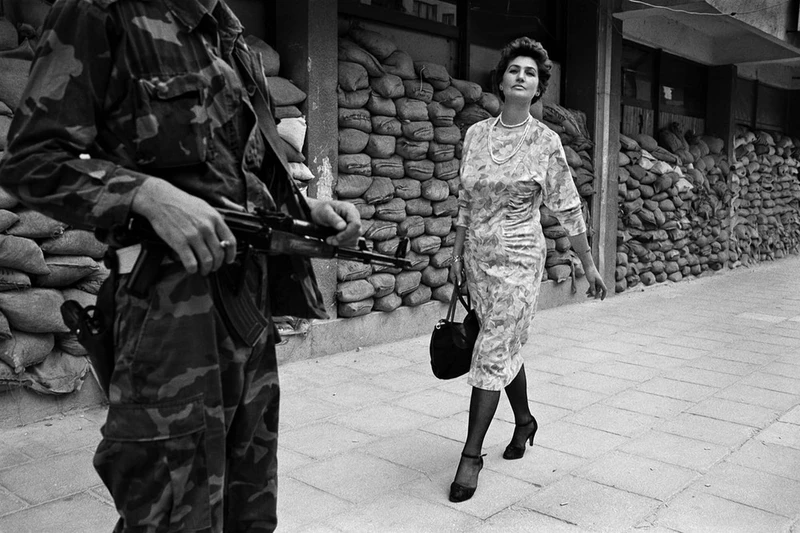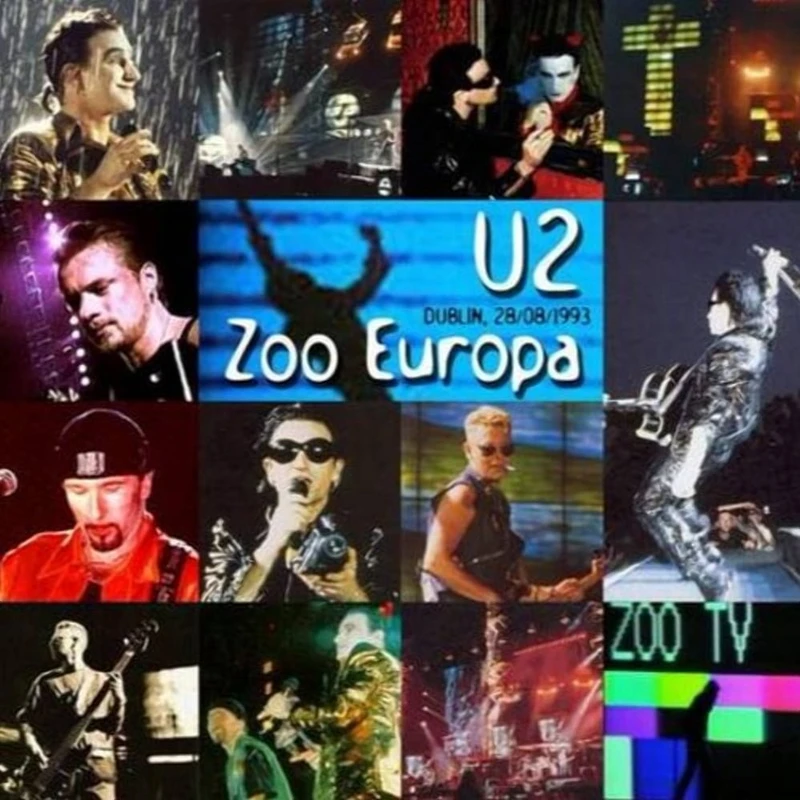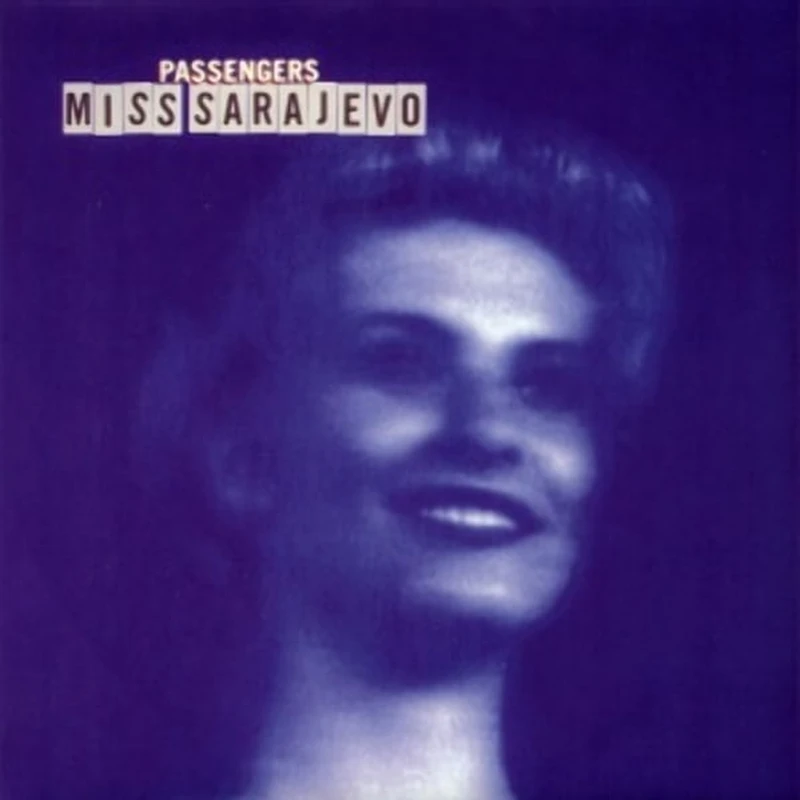«She Walks Through Life, Laughing»
You surely remember this photo, which circulated widely on social media early in the full-scale Russian invasion. It came with a poignant story meant to serve as motivation, a model to emulate, or “cosplay,” as some say today.
The year is 1995, the height of the brutal siege of Sarajevo, the Bosnian capital, by Serbian forces. Every day feels like the last; the risk of simply walking down the street and being killed by a sniper or a shell explosion is enormous. A beautiful woman, dressed to the nines—in a stunning dress, adorned with jewelry, and walking with an incredible proud and, in some ways, defiant stride—confidently passes enemy soldiers armed with rifles, showing by her very presence that she and her fellow citizens cannot be easily defeated.
The photo was taken in the Sarajevo suburb of Dobrinja, which, due to relentless shelling and destruction, was called “Little Hiroshima.” It was captured by British photographer Tom Stoddart, and the courageous woman is Meliha Varešanović. Seventeen years later, in January 2012, he returned to the same location and photographed the same strong Meliha, who, with her head held just as high and proud posture, walked down the same street again—symbolizing her own and the community’s spirit: “We won, and I assured everyone by my very appearance that we would not be defeated, and that this terrible time would one day end, like a bad nightmare.”

The Famous Photo by Tom Stoddart
The Siege of Sarajevo, a city that had hosted the Winter Olympics less than ten years earlier, lasted 1,425 days—almost four years. According to various sources, between 10,000 and 15,000 people died in this war-torn city during that time. Unfortunately, Ukrainians know all too well what a humanitarian catastrophe means—not just from hearsay or online videos. During the siege, residents of the Bosnian capital survived on little more than bread and water (which wasn’t always available), suffering from shortages of medicine, electricity, and sometimes even candles, which had to be made from whatever was at hand. Cemeteries were overcrowded—bodies were buried in local stadiums and parks.
The Mission of Reporter Carter
In the winter of 1993, American journalist Bill Carter arrived in Sarajevo. Two years earlier, he had come to the Balkans on a humanitarian mission, delivering food and medicine to those affected. He found a small refuge in a bombed and burned office building and survived for the next six months on canned baby food washed down with water from local rivers and, as he later recalled, occasionally from sewage drains. His main task was to “build bridges” and establish any possible connection between the besieged city and the civilized Western world.
However, Carter’s intentions were not aimed at Western politicians, NGOs, or influential organizations like the UN (God forbid!). He deliberately focused on those who were genuinely changing the world for the better—those who were listened to, loved, and, most importantly, heard. Today, they might be called “thought leaders” or “influencers,” but back then they were famous rock musicians.
“The idea was simple,” Carter later recalled, “I wanted the youth of Europe to see the people in the war. I didn’t want them to see politicians, religious figures, or military personnel.” Thus, he reached out to Bono and the band U2.
On the last day of winter 1992, the Irish band U2 set off on their worldwide Zoo TV Tour, which lasted over a year and a half. It was a grand multimedia show featuring dozens of large screens, designed, among other things, to satirize modern television—which was already becoming empty, senseless, and propagandistic—and to create a “sensory overload” effect for the audience.

The screens broadcast random TV programs and shows, clips from music videos, various effects, and random phrases—“memes,” as we might call them today. It was something like modern Reels or TikTok content, but for a live audience of thousands. Additionally, there was constant interaction with viewers and fans—satellite calls took place, Bono randomly switched TV channels using a regular remote, and even made phone calls during the show, bringing people live into the “concert broadcast.” Keep in mind, this was before the internet era, and mobile communication was just emerging.
This kind of interactivity was exactly what Bill Carter needed. He managed to connect with Bono during the tour and even recorded several segments from besieged Sarajevo, though not live. Nevertheless, the connection with the pop star was established: the U2 frontman was deeply moved by the story. He initially planned to come to the city with a concert, but Carter dissuaded him due to the great danger—famous musicians could become hostages of the occupiers, and thousands of local spectators would be at risk from shelling.
It is important to emphasize Carter’s declared goal in this project: “to show the people inside the conflict, feeling the complete indifference of Western media to the human aspect of war.” Whether you like it or not, direct parallels with today’s Ukraine are unmistakable.
Beauty Will Save the World and Sarajevo
Meanwhile, something incredible was happening in Sarajevo, cut off from the civilized world and resources. On May 29, 1993, in one of the city’s safe basement shelters, locals decided to hold… a beauty contest. It was called “Miss Besieged Sarajevo ’93,” with sixteen young contestants participating. This was a real contest by all standards—with a jury, girls wearing makeup, dresses, high heels, swimsuit rounds, and smiles. That smile was the most powerful element of this remarkable act—to smile despite everything, through tears, in defiance of the enemy nearby—perhaps even in the next block. The occupiers expected the night to pass in fear and darkness, but no: “We will have fun, rejoice in life, and enjoy beauty.” It was an extraordinarily powerful gesture.
The winner of the contest was 17-year-old blonde Inela Nogić. When journalists asked her after the event what she planned to do next, she replied: “I have no plans, because I might be killed tomorrow.”

The winner of the “Miss Besieged Sarajevo ’93” contest was Inela Nogić.
Today, Inela lives in Amsterdam with her second husband, has two children, and has worked in the European modeling industry. At the contest finale, Bosnian girls carried a huge banner on stage that read: “DON’T LET THEM KILL US.”
By some miracle, Bill Carter managed to obtain a small handheld video camera sent to him from the United States, with which he recorded this historic event. From this footage, the 33-minute documentary Miss Sarajevo was later produced.
Inspired by this story, Bono, along with the members of U2 and the band’s then-producer Brian Eno, recorded the song “Miss Sarajevo,” which they later released under the project name Passengers. In one of the two edited videos for the song, you can see documentary footage from that historic beauty contest, chronicles of burning Sarajevo, and once-incomprehensible scenes of peaceful residents making short dashes through the besieged city. Here is that video:
The legendary tenor Luciano Pavarotti participated in the recording of the song, whose unique voice not only enriched the composition but also drew global attention to the events unfolding in the former Yugoslavia—right in the heart of Europe. A few years later, George Michael also added the song to his repertoire.
The Passengers single was released in September 1995, featuring a photo of the contest winner, Inela Nogić, on the cover. Six months later, on February 29, 1996, the four-year siege of Sarajevo ended—exactly four years after U2 embarked on their Zoo TV Tour.
On September 23, 1997, U2 performed at the Koševo Olympic Stadium in Sarajevo, becoming the first foreign band to play in the country after the siege ended. Inela Nogić, Miss Besieged Sarajevo ’93, was invited to attend the concert.

The cover of the single Miss Sarajevo
Among other things, this story is also about how, in modern human history—after enduring two world wars in the twentieth century (the first of which, by the way, began in Sarajevo)—something seemingly wild and incredible happened at the century’s end: the siege and humanitarian catastrophe of an entire city in the heart of Europe, the capital of a sovereign state. Tens of thousands of people then appealed to the global community, politicians, and the press: “Don’t let them kill us!”—sending signals to the world in various ways. Perhaps one of these—maybe this musical one—worked.
It is also a story about never losing hope for better, even under the most terrible circumstances, and sometimes facing those circumstances with a broad smile and a proud head held high, as Bosnian Meliha Varešanović did.
In early May 2022, less than three months after Putin’s forces intended to invade the Ukrainian capital, U2’s leader Bono and guitarist The Edge unexpectedly visited Kyiv and performed in the city’s metro. Even before the war, the appearance of this band performing in Ukraine was a dream for many compatriots. We hope it will happen soon—immediately after our victory.
